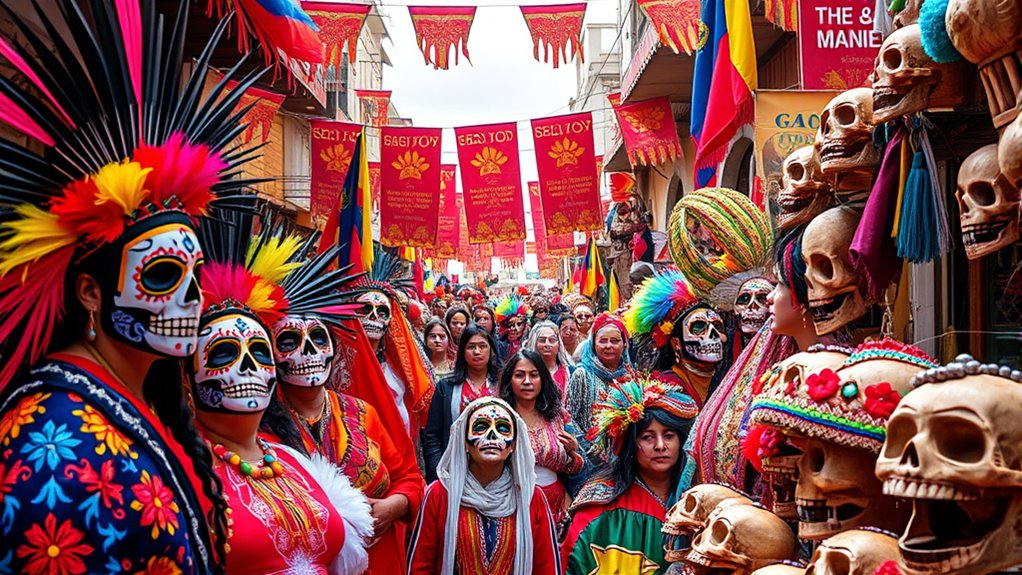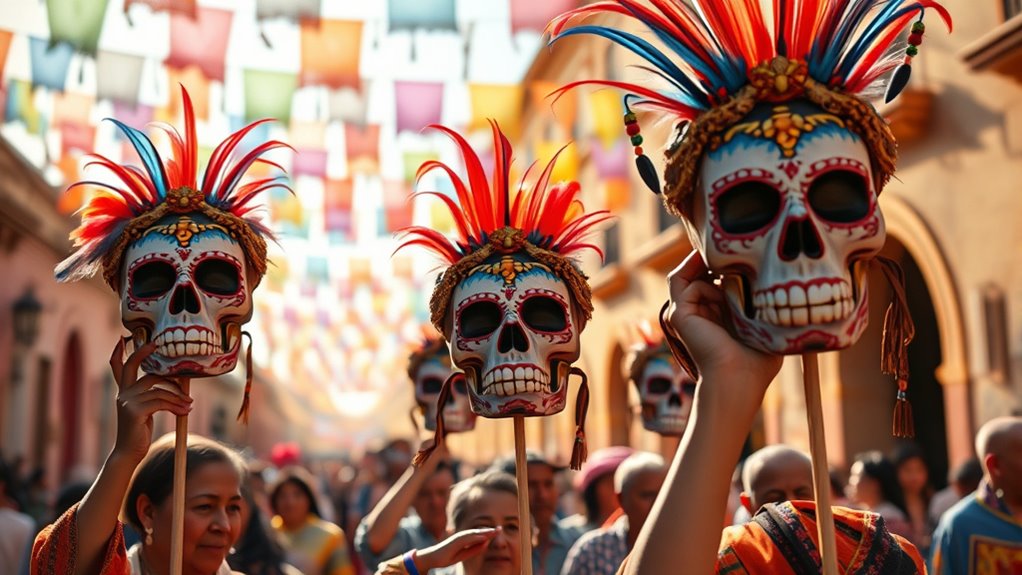On Bolivia’s Day of Skulls, you witness a vibrant celebration honoring ancestors and cultural heritage. Colorful decorations, offerings like coca leaves and food, and rituals create a powerful connection to the spiritual world. Communities come together through music, dance, and prayer, emphasizing respect for lineage and tradition. This event reinforces social bonds and keeps centuries-old customs alive. If you explore further, you’ll discover even more about the rich symbolism and significance behind this meaningful tradition.
Key Takeaways
- The Day of Skulls honors ancestors and cultural heritage, especially among indigenous Aymara and Quechua communities.
- Skulls are decorated with flowers, fabrics, and offerings, symbolizing reverence and spiritual connection.
- Rituals include offering food, coca leaves, and prayers to invite ancestral guidance and protection.
- Community gatherings feature traditional music, dance, and storytelling, fostering social bonds and cultural continuity.
- The celebration reinforces indigenous identity, honoring life, death, and the ongoing presence of ancestors.

In Bolivia, the Day of Skulls tradition is a powerful and vibrant celebration that honors the ancestors and preserves cultural heritage. This event is deeply rooted in the indigenous communities, especially among the Aymara and Quechua peoples, serving as a crucial link between past and present. As you observe this tradition, you’ll notice how the cultural significance extends beyond mere remembrance; it embodies a profound respect for lineage, history, and the spiritual world. The ritual practices involved are both symbolic and communal, creating a connection that transcends generations.
During the celebrations, you’ll see skulls of loved ones displayed prominently, often decorated with colorful fabrics, flowers, and offerings. These skulls are more than relics; they are considered sacred vessels that carry the spirits of ancestors. The display of skulls is a conscious act of remembrance, emphasizing the importance of ancestral guidance in daily life. In these rituals, community members come together to honor their ancestors through prayer, singing, and recitation of traditional stories. These practices serve to reinforce social bonds and reaffirm cultural identity, making the Day of Skulls a crucial act of cultural continuity.
Skulls decorated with flowers and fabrics symbolize ancestral spirits, reinforcing cultural identity and community bonds during Bolivia’s Day of Skulls.
The ritual practices surrounding the Day of Skulls are deeply symbolic. For example, offerings such as food, coca leaves, and alcohol are presented to the spirits, believed to nourish and appease them. These offerings are carefully arranged on altars or around the skulls, symbolizing respect and gratitude. Additionally, the use of traditional music and dance during the festivities enhances the spiritual atmosphere, creating a sacred space where the living and the dead coexist. The community often gathers around these altars at dusk or dawn, engaging in prayers that invoke protection, guidance, and blessings from the ancestors. A sense of community is central to these celebrations, strengthening social cohesion and shared cultural values.
You’ll also notice that the rituals are performed with a sense of reverence and joy, reflecting a worldview that celebrates life and death as interconnected. The Day of Skulls is not viewed as a somber occasion but as a time to honor the continuity of life and cultural heritage. It’s a reminder that the ancestors remain present in daily life, guiding and watching over the community. Through these ritual practices, you see how tradition sustains identity, fosters unity, and keeps alive centuries-old beliefs and customs, making the Day of Skulls an essential part of Bolivia’s rich cultural tapestry.
Frequently Asked Questions
How Did the Day of Skulls Tradition Originate in Bolivia?
You might wonder how the Day of Skulls tradition started in Bolivia. It originates from ancient rituals where communities used skulls as cultural symbolism to honor ancestors and celebrate life and death. These practices reflect deep-rooted beliefs about mortality and spirituality. Over time, the tradition evolved into a vibrant cultural event, blending indigenous customs with modern festivities, allowing people to reconnect with their history and pay homage to those who came before them.
Are There Specific Regions in Bolivia More Associated With This Tradition?
You’ll find that certain regions in Bolivia are more closely associated with this tradition, reflecting diverse regional customs and cultural variations. For example, in La Paz and Oruro, the Day of Skulls is especially prominent, with unique rituals and celebrations. These areas often preserve more traditional practices, making them key locations for experiencing the full cultural significance of the day. Your experience will be richer by exploring these specific regions.
What Materials Are Used to Prepare the Skull Displays?
You’ll find that skull displays are crafted from real bones or sometimes molded materials. Artists often use bone crafts to shape the skulls, then decorate them with vibrant, decorative paint to create striking designs. These materials enhance the cultural significance and visual appeal of the displays. Whether real or synthetic, the careful craftsmanship and colorful paint bring the skulls to life, honoring traditions and storytelling through vivid, meaningful art.
How Do Locals Perceive the Significance of the Skulls Today?
You might think locals see skulls as mere decorations, but actually, they’re the heartbeat of cultural symbolism. Today, community participation keeps the tradition alive, transforming skulls into powerful symbols of remembrance and resilience. Locals perceive these displays as more than history—they’re a vibrant reminder of ancestors and identity. So, while outsiders might see bones, insiders see stories, strength, and a shared spirit that binds the community in honoring their past.
Are There Any Modern Influences Shaping the Tradition’S Evolution?
You might notice that modern influences, like cultural adaptations and tourism impact, are shaping the tradition’s evolution. Locals sometimes incorporate new elements to attract visitors while preserving its core meaning. This blending of tradition and modernity helps keep the Day of Skulls relevant, but it also raises questions about maintaining authenticity. Overall, these changes reflect a dynamic culture that respects its roots while embracing contemporary influences.
Conclusion
As you walk through Bolivia’s Day of Skulls, you become part of a living tapestry where history and spirit dance together. The vibrant skulls, like colorful whispers from the past, remind you that life and death are two sides of the same coin. Embrace this tradition’s haunting beauty, where every skull tells a story, turning the ordinary into an extraordinary tribute. In this carnival of memories, you find that honoring the dead breathes life into the present.










